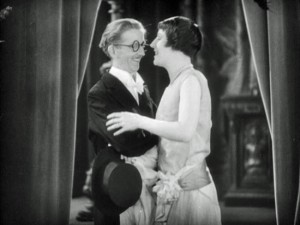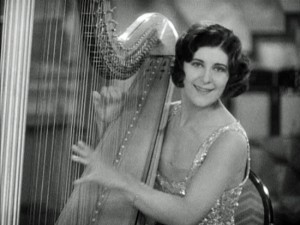Some Memorable Screenings in 2011
In lieu of a list of my top 10 films of the year, here’s a look back at some of the best experiences I had at the theaters
/https://tf-cmsv2-smithsonianmag-media.s3.amazonaws.com/filer/20111228102137Val_Ernie_Stanton_thumb.jpg)
In a perfect world, Top Ten lists would entertain as well as illuminate, without condescension or elitism. In practice, “Top Ten” or “Best of” lists either confirm or deny your tastes, at the same time calling into question your standards and your commitment to the subject at hand. I have to say it’s a bit dismaying to look over a Top Ten Rock Singles or Ten Best Novels and realize I don’t know any of them.
Film critics—some of them anyway—get paid not only to see movies, but to impress you with their opinions. Too many use the latter as an opportunity to show off, to remind you that you didn’t get to go to a festival in Cannes or Venice, that you didn’t chat with this director or that star, that your town might not even support a repertory theater.
I’m just as starstruck as anyone else, and I still get excited when a big-budget mainstream film turns out beautifully, or when someone screens an obscure title that turns out to be great. But rather than tout a film that you probably already decided to see (or avoid), I’m going to use this space to describe my most memorable screening experiences this year.
1. Amateur Night. I’ve written about this collection of home movies before, and was lucky enough to view the film back in January. I didn’t expect Amateur Night to be so moving, but catching glimpses of the past in these unguarded, innocent pieces proved surprisingly poignant. Watching Alfred Hitchcock, the Master of Suspense, in a backyard frolicking with his daughter Patricia transormed him from a remote “great artist” to a more approachable proud father. I hope that filmmaker Dwight Swanson—who assembled the film with the help of several archives—can schedule more screenings in the coming year. As he pointed out before, it’s unlikely that Amateur Night will ever be available on home video.
2. Vitaphone Vaudeville of 2011. For the past several years, Bruce Goldstein at New York’s Film Forum has scheduled a night of Vitaphone shorts, introduced by Ron Hutchinson of the invaluable Vitaphone Project. Vitaphone shorts were one of the ways the Warner Bros. studio introduced sound to moviegoers in the late 1920s. At first just filmed records of stage acts, they later evolved into mini-playlets that featured future movie stars like Pat O’Brien and Spencer Tracy. Fortunately for us they also captured an era of vaudeville that was just about to disappear. This is what entertained the masses back then: musicians, dancers, comedians, and novelty acts, one after the other in dizzying succession. My favorite of the night was Conlin and Glass in Sharps and Flats, a slice of raunchy, roughhouse slapstick that kept veering into bizarre tangents.
The Vitaphone Project has helped locate and restore these shorts; more important, Hutchinson and his colleagues have made them available to the public in screenings across the country. Even better, you can obtain dozens of them, including Sharps and Flats, from the Warner Bros. Archive.
3. 3-D Is Coming to This Theater! Back in October, Stefan Drössler delivered a talk at the Museum of Modern Art that covered 3-D processes from around the world, including clips of shorts and features from Russia, Hungary, and Hong Kong. I hadn’t seen the program when I wrote about it in October, but it turned out to be as thrilling a show as I attended all year. Used properly, 3-D can make you a participant in a film narrative in a way that no flat process can duplicate. The problem is, so few filmmakers know how to use it, as titles like Sucker Punch!, The Green Lantern, and Priest proved.

Conlin and Glass in Sharps and Flats. All three pictures are frame enlargements from Vitaphone shorts.
Drössler’s well-chosen clips ranged from martial arts to erotica, but it was otherwise negligible films like an Alpine travelogue that really impressed me. Snow churned up by skis was so realistic it seemed to fly into your face. And two films by Georges Méliès (who has to be regarded as the film comeback of the year) were simply astonishing. To try to prevent piracy, Méliès used a two-camera set-up: one negative for Europe, the other for North America. Thanks to modern computing, these complementary negatives can be adapted to 3-D, as Drössler showed with The Oracle of Delphi and The Infernal Cauldron, both from 1903. The films themselves didn’t change: the sets, the acting, the editing all remained the same. But the 3-D process gave them a wonderful depth and gravity. The characters’ movements seemed more lifelike, and the sets and props more substantial. As viewers it felt as if we were being drawn into the actual filming process, eyewitnesses to Méliès and his actors at work. The experience made a project to convert Charlie Chaplin shorts to 3-D a lot more palatable.
4. A Trip to the Moon. One of my first pieces for Reel Culture was about the restoration of this landmark of early cinema. I didn’t get to see it until Serge Bromberg brought it to the Museum of Modern Art in November, along with his expertly made and moving documentary about Georges Méliès, The Extraordinary Voyage. Learning about the restoration process behind the film was one thing. Actually seeing A Trip to the Moon projected in 35mm, with Bromberg accompanying it on piano, connected me and the rest of the audience with the very beginnings of cinema.
Sadly, bad screenings outweighed the good in 2011. Whether it was Russell Brand in a crushing, clanking remake of Arthur, or the blaring, overstuffed Cars 2—Pixar’s first disappointing film—terrible movies lurked everywhere. Just last night my wife and I saw enough of Undercover Christmas to realize that the filmmakers had not just stolen the premise from Remember the Night, but transformed that remarkable film into a degrading mess.
/https://tf-cmsv2-smithsonianmag-media.s3.amazonaws.com/accounts/headshot/daniel-eagan-240.jpg)

/https://tf-cmsv2-smithsonianmag-media.s3.amazonaws.com/accounts/headshot/daniel-eagan-240.jpg)